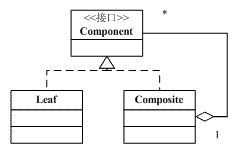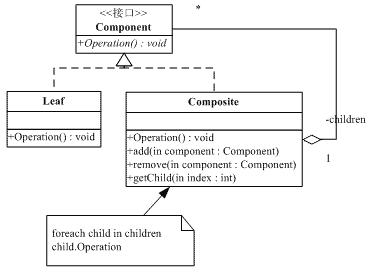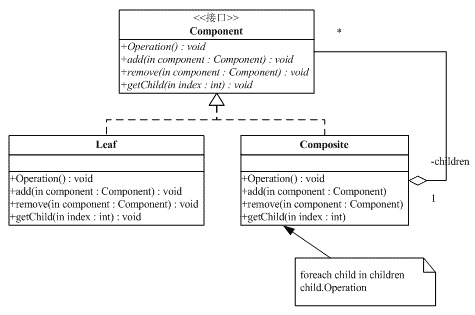关于组合模式,我本来写了很多,可是当看到吕振宇老哥的文章后,我觉得他那篇讲组合模式的文章是最好的,所以,删去了我原先的文章,这里部分引用他的。在结尾加一些我自己的理解。
合成模式有时又叫做部分-整体模式(Part-Whole)。合成模式将对象组织到树结构中,可以用来描述整体与部分的关系。合成模式可以使客户端将单纯元素与复合元素同等看待。
对象的树结构
一个树结构由两种节点组成:树枝节点和树叶节点。树枝节点可以有子节点,而一个树叶节点不可以有子节点。除了根节点外,其它节点有且只有一个父节点。
注意:一个树枝节点可以不带任何叶子,但是它因为有带叶子的能力,因此仍然是树枝节点,而不会成为叶节点。一个树叶节点永远不可能带有子节点。
二、 合成模式概述
下图所示的类图省略了各个角色的细节。

可以看出,上面的类图结构涉及到三个角色:
- 抽象构件(Component)角色:这是一个抽象角色,它给参与组合的对象规定一个接口。这个角色给出共有接口及其默认行为。
- 树叶构件(Leaf)角色:代表参加组合的树叶对象。一个树叶对象没有下级子对象。
- 树枝构件(Composite)角色:代表参加组合的有子对象的对象,并给出树枝构件对象的行为。
可以看出,Composite类型的对象可以包含其它Component类型的对象。换而言之,Composite类型对象可以含有其它的树枝(Composite)类型或树叶(Leaf)类型的对象。
合成模式的实现根据所实现接口的区别分为两种形式,分别称为安全模式和透明模式。合成模式可以不提供父对象的管理方法,但合成模式必须在合适的地方提供子对象的管理方法(诸如:add、remove、getChild等)。
透明方式
作为第一种选择,在Component里面声明所有的用来管理子类对象的方法,包括add()、remove(),以及getChild()方法。这样做的好处是所有的构件类都有相同的接口。在客户端看来,树叶类对象与合成类对象的区别起码在接口层次上消失了,客户端可以同等同的对待所有的对象。这就是透明形式的合成模式。
这个选择的缺点是不够安全,因为树叶类对象和合成类对象在本质上是有区别的。树叶类对象不可能有下一个层次的对象,因此add()、remove()以及getChild()方法没有意义,是在编译时期不会出错,而只会在运行时期才会出错。
安全方式
第二种选择是在Composite类里面声明所有的用来管理子类对象的方法。这样的做法是安全的做法,因为树叶类型的对象根本就没有管理子类对象的方法,因此,如果客户端对树叶类对象使用这些方法时,程序会在编译时期出错。
这个选择的缺点是不够透明,因为树叶类和合成类将具有不同的接口。
这两个形式各有优缺点,需要根据软件的具体情况做出取舍决定。
三、 安全式的合成模式的结构
安全式的合成模式要求管理聚集的方法只出现在树枝构件类中,而不出现在树叶构件中。

这种形式涉及到三个角色:
- 抽象构件(Component)角色:这是一个抽象角色,它给参加组合的对象定义出公共的接口及其默认行为,可以用来管理所有的子对象。在安全式的合成模式里,构件角色并不是定义出管理子对象的方法,这一定义由树枝构件对象给出。
- 树叶构件(Leaf)角色:树叶对象是没有下级子对象的对象,定义出参加组合的原始对象的行为。
- 树枝构件(Composite)角色:代表参加组合的有下级子对象的对象。树枝对象给出所有的管理子对象的方法,如add()、remove()、getChild()等。
四、 安全式的合成模式实现
以下示例性代码演示了安全式的合成模式代码:
 // Composite pattern -- Structural example
// Composite pattern -- Structural example  using System;
using System; using System.Text;
using System.Text; using System.Collections;
using System.Collections;
 // "Component"
// "Component" abstract class Component
abstract class Component {
{ // Fields
// Fields protected string name;
protected string name;
 // Constructors
// Constructors public Component( string name )
public Component( string name ) {
{ this.name = name;
this.name = name; }
}
 // Operation
// Operation public abstract void Display( int depth );
public abstract void Display( int depth ); }
}
 // "Composite"
// "Composite" class Composite : Component
class Composite : Component {
{ // Fields
// Fields private ArrayList children = new ArrayList();
private ArrayList children = new ArrayList();
 // Constructors
// Constructors public Composite( string name ) : base( name ) {}
public Composite( string name ) : base( name ) {}
 // Methods
// Methods public void Add( Component component )
public void Add( Component component ) {
{ children.Add( component );
children.Add( component ); }
} public void Remove( Component component )
public void Remove( Component component ) {
{ children.Remove( component );
children.Remove( component ); }
} public override void Display( int depth )
public override void Display( int depth ) {
{ Console.WriteLine( new String( '-', depth ) + name );
Console.WriteLine( new String( '-', depth ) + name );
 // Display each of the node's children
// Display each of the node's children foreach( Component component in children )
foreach( Component component in children ) component.Display( depth + 2 );
component.Display( depth + 2 ); }
} }
}
 // "Leaf"
// "Leaf" class Leaf : Component
class Leaf : Component {
{ // Constructors
// Constructors public Leaf( string name ) : base( name ) {}
public Leaf( string name ) : base( name ) {}
 // Methods
// Methods public override void Display( int depth )
public override void Display( int depth ) {
{ Console.WriteLine( new String( '-', depth ) + name );
Console.WriteLine( new String( '-', depth ) + name ); }
} }
}
 /// <summary>
/// <summary> /// Client test
/// Client test /// </summary>
/// </summary> public class Client
public class Client {
{ public static void Main( string[] args )
public static void Main( string[] args ) {
{ // Create a tree structure
// Create a tree structure Composite root = new Composite( "root" );
Composite root = new Composite( "root" ); root.Add( new Leaf( "Leaf A" ));
root.Add( new Leaf( "Leaf A" )); root.Add( new Leaf( "Leaf B" ));
root.Add( new Leaf( "Leaf B" )); Composite comp = new Composite( "Composite X" );
Composite comp = new Composite( "Composite X" );
 comp.Add( new Leaf( "Leaf XA" ) );
comp.Add( new Leaf( "Leaf XA" ) ); comp.Add( new Leaf( "Leaf XB" ) );
comp.Add( new Leaf( "Leaf XB" ) ); root.Add( comp );
root.Add( comp );
 root.Add( new Leaf( "Leaf C" ));
root.Add( new Leaf( "Leaf C" ));
 // Add and remove a leaf
// Add and remove a leaf Leaf l = new Leaf( "Leaf D" );
Leaf l = new Leaf( "Leaf D" ); root.Add( l );
root.Add( l ); root.Remove( l );
root.Remove( l );
 // Recursively display nodes
// Recursively display nodes root.Display( 1 );
root.Display( 1 ); }
} }
}
五、 透明式的合成模式结构
与安全式的合成模式不同的是,透明式的合成模式要求所有的具体构件类,不论树枝构件还是树叶构件,均符合一个固定的接口。

这种形式涉及到三个角色:
- 抽象构件(Component)角色:这是一个抽象角色,它给参加组合的对象规定一个接口,规范共有的接口及默认行为。
- 树叶构件(Leaf)角色:代表参加组合的树叶对象,定义出参加组合的原始对象的行为。树叶类会给出add()、remove()以及getChild()之类的用来管理子类对对象的方法的平庸实现。
- 树枝构件(Composite)角色:代表参加组合的有子对象的对象,定义出这样的对象的行为。
六、 透明式的合成模式实现
以下示例性代码演示了安全式的合成模式代码:
 // Composite pattern -- Structural example
// Composite pattern -- Structural example 
 using System;
using System; using System.Text;
using System.Text; using System.Collections;
using System.Collections;
 // "Component"
// "Component" abstract class Component
abstract class Component {
{ // Fields
// Fields protected string name;
protected string name;
 // Constructors
// Constructors public Component( string name )
public Component( string name ) { this.name = name; }
{ this.name = name; }
 // Methods
// Methods abstract public void Add(Component c);
abstract public void Add(Component c); abstract public void Remove( Component c );
abstract public void Remove( Component c ); abstract public void Display( int depth );
abstract public void Display( int depth ); }
}
 // "Composite"
// "Composite" class Composite : Component
class Composite : Component {
{ // Fields
// Fields private ArrayList children = new ArrayList();
private ArrayList children = new ArrayList();
 // Constructors
// Constructors public Composite( string name ) : base( name ) {}
public Composite( string name ) : base( name ) {}
 // Methods
// Methods public override void Add( Component component )
public override void Add( Component component ) { children.Add( component ); }
{ children.Add( component ); }
 public override void Remove( Component component )
public override void Remove( Component component ) { children.Remove( component ); }
{ children.Remove( component ); }
 public override void Display( int depth )
public override void Display( int depth ) {
{  Console.WriteLine( new String( '-', depth ) + name );
Console.WriteLine( new String( '-', depth ) + name );
 // Display each of the node's children
// Display each of the node's children foreach( Component component in children )
foreach( Component component in children ) component.Display( depth + 2 );
component.Display( depth + 2 ); }
} }
}
 // "Leaf"
// "Leaf" class Leaf : Component
class Leaf : Component {
{ // Constructors
// Constructors public Leaf( string name ) : base( name ) {}
public Leaf( string name ) : base( name ) {}
 // Methods
// Methods public override void Add( Component c )
public override void Add( Component c ) { Console.WriteLine("Cannot add to a leaf"); }
{ Console.WriteLine("Cannot add to a leaf"); }
 public override void Remove( Component c )
public override void Remove( Component c ) { Console.WriteLine("Cannot remove from a leaf"); }
{ Console.WriteLine("Cannot remove from a leaf"); }
 public override void Display( int depth )
public override void Display( int depth ) { Console.WriteLine( new String( '-', depth ) + name ); }
{ Console.WriteLine( new String( '-', depth ) + name ); } }
}
 /// <summary>
/// <summary> /// Client test
/// Client test /// </summary>
/// </summary> public class Client
public class Client {
{ public static void Main( string[] args )
public static void Main( string[] args ) {
{ // Create a tree structure
// Create a tree structure Composite root = new Composite( "root" );
Composite root = new Composite( "root" ); root.Add( new Leaf( "Leaf A" ));
root.Add( new Leaf( "Leaf A" )); root.Add( new Leaf( "Leaf B" ));
root.Add( new Leaf( "Leaf B" )); Composite comp = new Composite( "Composite X" );
Composite comp = new Composite( "Composite X" );
 comp.Add( new Leaf( "
comp.Add( new Leaf( "

